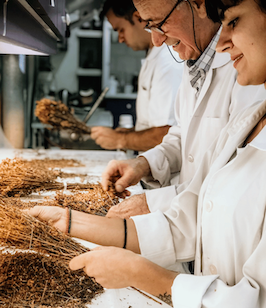Characteristics of Anise
The anise plant (aniseed - Pimpinella anisum) belongs to the Apidae family (Apiaceae), of aromatic plants and is cultivated for its aromatic seed. It originates from Egypt, Western Asia and the Eastern Mediterranean. It is a native plant (like oregano, nettle, marjoram.) and in Greece it grows mainly on the islands. The plant reaches about 90 centimeters in height, has large, dark green leaves at its base, while at the highest point of the plant there are small leaves and white flowers, which bloom from June to August. It is resistant to drought, hot temperatures and vulnerable to cold.
The fruit is harvested in July and is used in bakeries, confectionery, winemaking (it is added to tsipouro as a flavoring) and in herbal medicine.
Its many medicinal benefits have been known since ancient times. It fights colds, helps people with respiratory diseases, is a source of vitamins (A, B, C) and trace elements (calcium, iron). In addition, it has anxiolytic and sedative properties.
History of Anise
Anise is estimated to have been cultivated and used since 1,500 BC. The ancient Egyptians knew the benefits of the plant and considered it a painkiller and diuretic, while it was part of sacred ceremonies in combination with other herbs.
In ancient Greece, the aromatic fruits of the plant were considered valuable due to their many medicinal properties. They believed that it acted as an analgesic and facilitated breathing in cases of congestion. They also used anise as a medicine for colds, a fact supported by Hippocrates, who prepared “anissite wine”, a recipe that contained wine, water and anise.
This recipe also reached Rome, where it became known as "Hippocrates' wine" and was drunk to aid digestion.
During the Middle Ages, anise spread throughout Europe and other cultures began adding it as a flavoring to cooking. Today, anise is widely added to herbal or seed blends to treat bloating, along with fennel, dill, coriander, and cumin.
Ingredients
Anise essential oil from the seeds of the plant using the cold-pressed method.
Chemical composition of anise essential oil
80%-90% trans-anethole, estragole, c-hymachalen, para-anisaldehyde methyl cavicol. (E)- methyleugenol, a-cuparene, a-himachalene, b-bisabolene, p-anisaldehyde, cis-anethole.
Instructions for use
- Combine anise essential oil with eucalyptus in the burner to release the blockage.
- For relief from intestinal bloating and abdominal pain, add 1 drop of anise essential oil to a drink containing boiled fennel, coriander and cumin seeds.
- In a warm bath, add 5 drops of anise essential oil to treat joint pain.
- It is used in perfumery, candle and soap production.
- Body mist: in 100 ml of water add 4 drops of anise essential oil and 4 drops of mastic oil, shake well before use and spray on the body for a natural aroma.
- It combines well with eucalyptus essential oil, rosemary and essential oil of mint, tangerine, cedar, fennel, coriander.
Chinese medicine
Anise is known in PKI as Da Xui Xang and has been used for centuries to move Qi, vital energy, eliminate cold, menstrual cramps, relieve arthritic pain, intestinal bloating and indigestion.
Anise essential oil combined with almond oil is applied to specific acupuncture points to enhance digestion of the stomach and intestines.
Useful tips
- The use of essential oils should be avoided during pregnancy, breastfeeding and by young children.
- Avoid direct contact with skin, eyes and mouth.
- Always use essential oils dissolved in a base oil or other catalyst.
Instructions
Ingredients
Changes and returns
- We offer FREE returns on all eligible products that are not related to personal hygiene, galenic products, or special preparations. These items cannot be returned due to strict hygiene and safety regulations.
-
Έχετε δικαίωμα να επιστρέψετε οποιοδήποτε επιλέξιμο προϊόν εντός 14 ημερολογιακών ημερών από την ημέρα που παραλάβατε την παραγγελία σας.
- Products must be intact, unused, and in their original packaging for us to accept their return. Proof of purchase is also required.
- Μετά την παραλαβή και τον σχολαστικό έλεγχο των προϊόντων, η επιστροφή χρημάτων γίνεται εντός 5–10 εργάσιμων ημερών.
- For purchases up to €50, returns may be issued as a gift card so you can benefit immediately from your next purchase.
- Return process: Submit a request from footer with one click at Request a return & declare the return product.
- DRead our full Returns Policy on our website.
- Παρακαλούμε μην αποστείλετε κανένα προϊόν πριν λάβετε το σχετικό shipping label από εμάς.
Metaphorically
Χρόνος & Ώρες Παράδοσης
Delivery Time: (calculated from the shipping date as the start date, not the order date, and only business days are counted).
- Αστικά κέντρα, Αττική & Πρωτεύουσες Νόμων (συμπεριλαμβανομένων της Κρήτης) : 1-3 εργάσιμες ημέρες
- Απομακρυσμένες περιοχές & Νησιωτικοί προορισμοί: 2-5 εργάσιμες ημέρες
- Delivery days are Monday through Friday
- Ώρες Παράδοσης: 9:00πμ.- 18:00 μμ. (κατά Προσέγγιση)
Έξοδα Αποστολής & Αντικαταβολή
- With BOX NOW, shipping costs are €2.95.
- Με COURIER tα έξοδα αποστολής για όλη την Ελλάδα είναι 4.50€.
- Cash on delivery is FREE
- Prices apply up to 2kg, each additional kilo is charged at €1
avgerinospharmacy.gr cannot be held responsible for any consequences due to delivery delays or loss of your parcel by the carrier or due to force majeure. In case your parcel is not received within the stated timeframes, an investigation with the carrier will be initiated and may last up to 15 days. During this period, no compensation or reshipment will be possible.
For all details, you can read our full shipping & delivery policy here.
4+1 gift!
Buy 4 Get 5






















